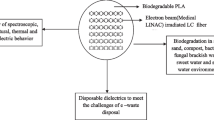Abstract
The biodegradation of electrospun nano-fibers of poly(ɛ-caprolactone) (PCL) was initially investigated with respect to the environmental application of PCL non-woven fabrics, using pure-cultured soil filamentous fungi, Aspergillus oryzae, Penicillium caseicolum, P. citrinum, Mucor sp., Rhizopus sp., Curvularia sp., and Cladosporium sp. Three kinds of non-woven PCL fabrics with different mean fiber diameters (330, 360, and 510 nm) were prepared by changing the viscosities of the pre-spun PCL solutions (150, 210, and 310 cPs, respectively). All of the pure-line soil filamentous fungi tested grew on the two fiber materials. Electron microscopy was used to observe the biodegradation processes revealing remarkable growth of two fungi, Rhizopus sp. and Mucor sp., along with the accompanying collapse of the nano-fiber matrices. In the biochemical oxygen demand (BOD) test, the biodegradation of the 330 nm PCL nano-fibers by Rhizopus sp. and Mucor sp. exceeded 20 and 30% carbon dioxide generation, respectively. The biodegradability of the PCL non-woven fabrics decreased with the mean fiber diameter and the 330 nm PCL nano-fiber that was made from 150 cPs solution (concentration, 7 wt%) exhibited the highest biodegradability. These results might offer some clues for the applications of the PCL non-woven fabrics having the controlled biodegradability in the environmental uses.
Similar content being viewed by others
References
H. Liu Y.L. Hsieh (2002) J. Polym. Sci. Part B: Polym. Phys. 40 2119
H. Fong I. Chen D. H. Reneker (1999) Polymer 40 4585
M. Bognitzki W. Czado T. Frese A. Schaper M. Hellwig M. Steinhart A. Greiner J. H. Wendorff (2001) Adv. Mater. 13 70
J. M. Deizel J. Kleinmeyer D. Harris N.C. BeckTan (2001) Polymer 42 261
Y.M. Shin M.M. Hohman M.P. Brenner G.C. Rutledge (2001) Polymer 42 9955
K.H. Lee H.Y. Kim Y.M. La D.R. Lee N.H. Sung (2002) J. Polym. Sci. Part B: Polym. Phys. 40 2259
K.H. Lee H.Y. Kim M.S. Khil Y.M. Ra D.R. Lee (2003) Polymer 44 1287
Formhals A. (1934) US Patent 1, 975, 504
G. I. Taylor (1969) Proc. Roy. Soc. London Ser. A 313 453
J. Doshi D. H. Reneker (1995) J. Electrostat 35 151
P. Gibson H.-Gibson Schreuder D. Rivin (2001) Colloid. Surface. A 187–188 469
X. Zong K. Kim D. Fang S. Ran B.S. Hsiao B. Chu (2002) Polymer 43 4403
W. Li C.T. Laurencin E.J. Caterson R.S. Tuan F.K. Ko (2002) J. Biomed Mater. Res. 60 613
C.J. Buchko K.M. Kozloff D.C. Martin (2001) Biomaterials 22 1289
M.J. Diamond B. Freedman J.A. Garibaldi (1975) Int. Biodeterior. Bull. 11 127
D. Goldberg (1995) J. Environ. Polym. Degrad. 3 61
M. Mochizuki T. Hayashi K. Nakayama T. Masuda M. Hirami R. Qian B.Z. Jiang A. Nakajima (1999) Pure Appl. Chem. 71 2177
E.D. Jackson A.G. Kempton (1975) Int. Biodeterior. Bull. 11 117
H. Nishida Y. Tokiwa (1993) J. Environ. Polym. Degrad. 1 227
A.C. Albertsson R. Renstad B. Erlandsson C. Eldsater S. Karlsson (1998) J. Appl. Polym. Sci. 70 61
Z. Gan J.T. Fung X. Jing C. Wu W.K. Kuliche (1998) Polymer 40 1961
S. C. Woodward P. S. Brewer F. Moatamed (1985) J. Biomed. Mater. Res. 19 437
Y. Tokiwa T. Ando T. Suzuki (1976) Hakko Kogaku Zasshi (in Japanese) 54 603
C.V. Benedict W.J. Cook P. Jarrett J.A. Cameron S.J. Huang J.P. Bell (1983) J. Appl. Polym. Sci. 28 327
J.G. Sanchez A. Tsuchii Y. Tokiwa (2000) Biotechnol. Lett. 22 849
H. Yoshimoto Y.M. Shin H. Terai J.P. Vacanti (2003) Biomaterials 24 2077
K. Ohkawa M. Yamada A. Nishida N. Nishi H. Yamamoto (2000) J. Polym. Environ. 8 59
Y. Doi K. Kasuya H. Abe N. Koyama S. Ishiwatari K. Takagi Y. Yoshida (1996) Polym. Degrad. Stab. 51 281
K. Kasuya K. Takagi S. Ishiwatari Y. Yoshida Y. Doi (1998) Polym. Degrad. Stab. 59 327
Author information
Authors and Affiliations
Corresponding author
Rights and permissions
About this article
Cite this article
Ohkawa, K., Kim, H. & Lee, K. Biodegradation of Electrospun Poly-(ɛ-caprolactone) Non-woven Fabrics by Pure-Cultured Soil Filamentous Fungi. J Environ Polym Degr 12, 211–218 (2004). https://doi.org/10.1007/s10924-004-8148-y
Issue Date:
DOI: https://doi.org/10.1007/s10924-004-8148-y




